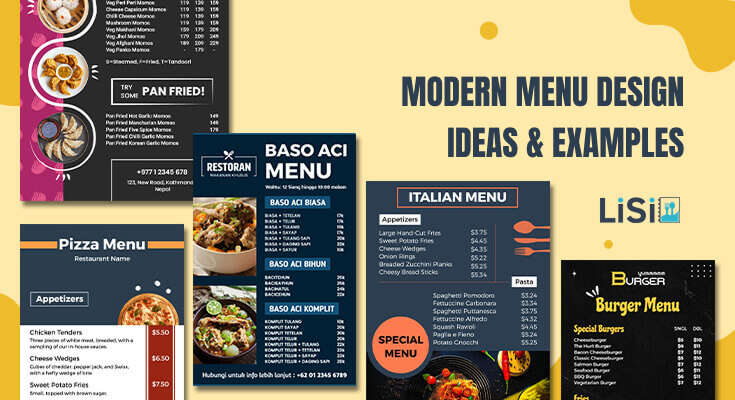Are you looking for modern menu design ideas for your restaurant? This guide is for you. The design of menus can influence customer decisions within seconds of opening. Moreover, studies show that well-designed menus can increase sales by up to 20%. However, many restaurants still struggle with outdated design approaches that fail to capture attention.
This comprehensive guide explores ideas, alongside cutting-edge modern menu design examples that drive sales and enhance customer experience.
Why Modern Menu Design Matters More in 2025?
Modern menu design extends far beyond listing food items and prices. Instead, it creates an emotional connection with diners while guiding their purchasing decisions. Furthermore, today’s consumers expect visually appealing, easy-to-navigate menus that reflect contemporary design trends.
The Psychology Behind Effective Menu Design
Restaurant owners often underestimate the psychological impact of menu design. However, research reveals fascinating insights about customer behavior:
Visual Hierarchy Influences Ordering Patterns
- Customers typically scan menus in a Z-pattern
- The upper right corner receives maximum attention
- Strategic placement increases item sales by 15-25%
Color Psychology Drives Appetite
- Warm colors like red and orange stimulate hunger
- Green suggests freshness and healthy options
- Black and gold convey premium quality
Typography Affects Perceived Value
- Script fonts suggest handcrafted, artisanal items
- Sans-serif fonts appear modern and clean
- Bold fonts draw attention to high-profit items
What are the Best Modern Menu Design Examples and Ideas?
These successful modern menu design examples provide inspiration and practical insights. Moreover, these examples demonstrate how different restaurants implement design principles.
1. Clean and Minimal Fine Dining Menu
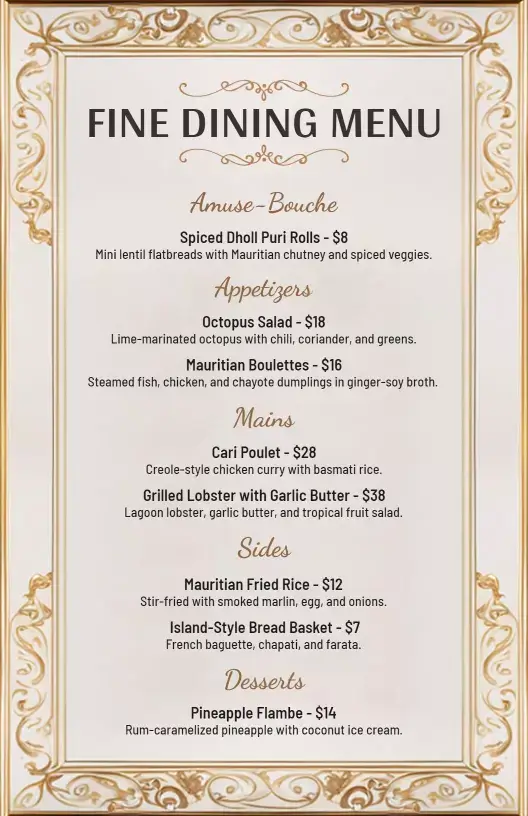
The clean and minimal menu design is a top choice for fine dining restaurants that want to create a sense of elegance, sophistication, and focus. This style avoids clutter and distractions, allowing the dishes—and the dining experience—to shine. It reflects the premium nature of the cuisine and gives customers a serene, upscale first impression the moment they open the menu.
This design typically uses ample white space, refined serif or modern sans-serif fonts, and a monochromatic or neutral color palette. Instead of bold colors or busy graphics, it keeps the focus on clarity and class.
Key features:
- Single-column layout for a focused reading experience
- High-contrast fonts, often black or dark gray on white or ivory backgrounds
- Elegant typography, typically using serif fonts for headings and clean sans-serifs for body text
- Plenty of white space to reduce visual noise and highlight individual items
- No images or icons, relying on well-written dish descriptions instead
Ultimately, this type of modern menu design creates a sophisticated feel, and makes customers keep focus on premium dishes, easy to scan.
2. Bold Street Food Menu Design
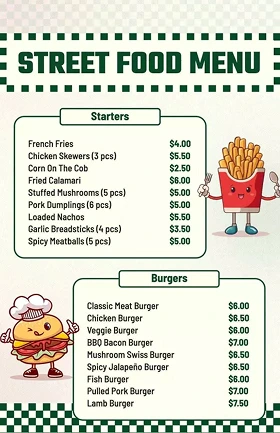
The bold street food menu design is energetic, eye-catching, and built to match the lively vibe of street food culture. This modern design style uses bright colors, large fonts, and playful visuals to grab attention quickly—perfect for fast-paced environments where customers make quick decisions. It often features creative icons, hand-drawn elements, and high-contrast combinations like yellow and black or red and white.
Designed for easy scanning, the layout uses clear item groupings and may include price tags, combo icons, or sticker-style highlights to promote deals. This type of menu is ideal for food trucks, pop-up stands, and quick-service joints where branding must be bold and memorable even at a glance.
Key Design Features:
- Bright, vibrant colors like red, orange, teal, or yellow to capture attention
- Large, chunky fonts for item names—often uppercase and styled like graffiti or block letters
- Icons and illustrations for food types (e.g., tacos, burgers, drinks)
- Highlight boxes or banners for combos, bestsellers, or spicy items
3. Digital QR Code Menu Design
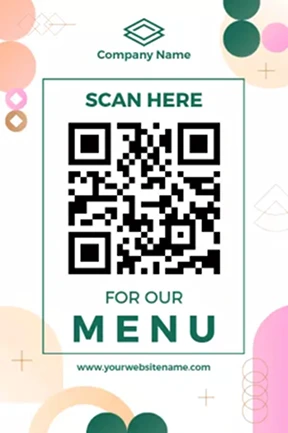
Digital QR code menu designs are a modern, tech-savvy solution that has quickly become a standard in restaurants, cafés, and bars—especially post-pandemic. Instead of handing out printed menus, restaurants place a scannable QR code on tables, counters, or walls. When customers scan it with their smartphone, it opens a mobile-optimized digital menu.
This menu is often scrollable, visually appealing, and interactive—sometimes even allowing customers to place orders or pay directly from their device.
Key Design Features:
- QR code placed visibly on tables, entry points, or menus
- Mobile-friendly layout with responsive design for all screen sizes
- Interactive elements like “Add to Cart,” filters (e.g., veg/non-veg), and collapsible sections
- Bright visuals or hero images for featured dishes or combos
- Search or filter option to quickly find items by category, diet, or popularity
Why it works: Contactless, easy to update, seamless for smartphone users.
4. Brunch Menu Design
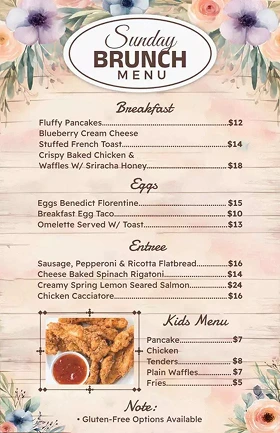
A photo-driven brunch menu is a visually engaging, modern menu style that uses high-quality food photography to entice customers and simplify decision-making. This type of design is especially effective for brunch cafés, where presentation and visual appeal are just as important as taste.
The layout usually features full-width or grid-style images of signature dishes like pancakes, avocado toast, smoothie bowls, and lattes. Each image is paired with minimal but clear text that includes the item name, a short description, and the price. This menu style often mimics Instagram or Pinterest aesthetics, which appeals to younger, image-driven diners.
Key Design Features:
- Full-page or section-based food photography that dominates the layout
- Bright, natural lighting in photos for a fresh, inviting look
- Minimal text overlays – just enough to label the dish and price
- Grid-style layout or scrollable image carousel (for digital menus)
- Soft color palette (pastels, whites, or neutrals) to keep the focus on food
This menu is bst for brunch spots, and breakfast cafés. Also, images help sell the food, especially for visual or indecisive customers.
5. Multi-Cuisine Menu Design
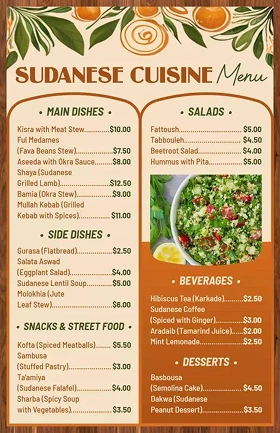
A multi-cuisine menu design is tailored for restaurants that serve a wide variety of dishes from different cultures—such as Indian, Chinese, Italian, Thai, or Continental. With such a diverse selection, the key to a modern multi-cuisine menu is organization, clarity, and visual separation. This design style uses clear category headings, color-coding, and visual dividers to help customers navigate a large menu easily.
It avoids overwhelming diners by breaking down the offerings into clearly labeled sections, often enhanced with icons, flags, or color bands representing each cuisine type. The layout can be horizontal or vertical, often split into panels or tabs (especially for digital menus) to keep everything neat and accessible.
Key Design Features:
- Color-coded sections to differentiate cuisines (e.g., green for Indian, red for Chinese)
- Well-structured layout with clear headings like “Appetizers – Indian”, “Pasta – Italian”, etc.
- Icons or national flags to identify dish origin
- Balanced use of images for key dishes only—not every item
- Compact item descriptions to avoid clutter while still highlighting ingredients
It simplifies complex offerings and helps customers navigate faster.
6. Chalkboard-Style Café Menu Design
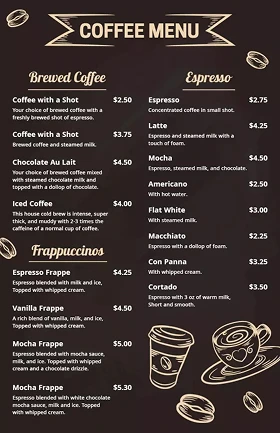
The chalkboard-style café menu is a charming, nostalgic, and visually engaging design that blends rustic aesthetics with modern café culture. Inspired by traditional chalkboards seen in European cafés and bakeries, this menu style features handwritten fonts, chalk textures, doodles, and illustrated borders. Whether used as an actual physical chalkboard or recreated digitally, it brings warmth and personality to the dining experience.
It’s especially effective for coffee shops, bakeries, dessert cafés, and small brunch spots where ambiance and customer connection matter. This style evokes a homemade, welcoming feel while still being organized and functional.
Key Design Features:
- Black or dark slate background resembling a chalkboard
- White or pastel-colored handwritten-style fonts for a casual, friendly tone
- Chalk doodles and illustrations like coffee cups, bread loaves, or utensils
- Simple layout – often single-column or side-by-side categories (e.g., Coffee | Pastries)
- Highlight boxes or frames for daily specials or “Staff Picks”
7. A La Carte Menu Style Design
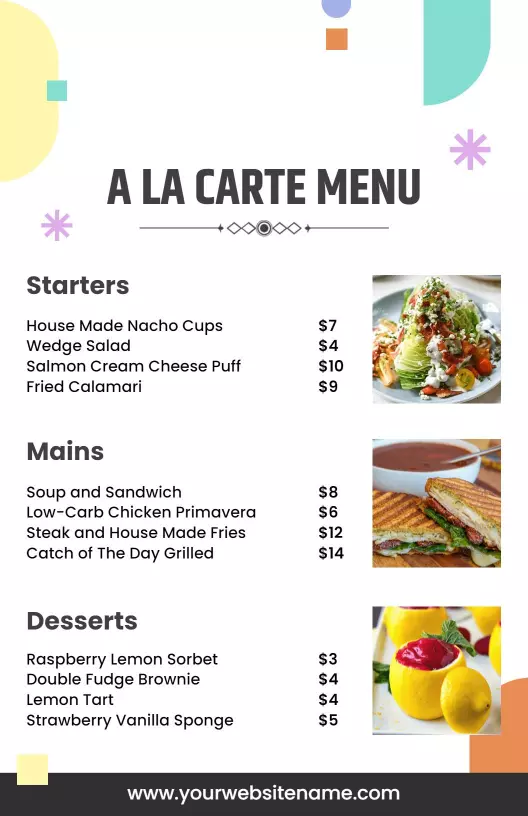
The a la carte menu style is a timeless yet modern approach that offers individual dishes priced separately, allowing customers full freedom to build their own meal. In contemporary restaurants, this style is being enhanced with clean layouts, thoughtful categorization, and subtle visual elements that make it easier to navigate.
Modern a la carte menus often adopt a minimalist look—combining structured sections like Starters, Mains, Sides, Desserts, and Add-ons with elegant typography and refined spacing. Some upscale or globally inspired restaurants add icons for dietary options, suggested pairings, or brief origin stories to highlight the uniqueness of each dish.
Key Design Features:
- Clearly separated sections such as Appetizers, Mains, Sides, and Desserts
- Individual pricing for each dish—no pre-fixed combinations
- Minimalist or modern design with clean fonts and generous white space
- Short, elegant descriptions focusing on ingredients or technique
- Optional wine or beverage pairings are listed under certain dishes
Why it works best: Guests choose exactly what they want, enhancing satisfaction. Also suits diverse preferences–Ideal for groups with different dietary or portion needs
Check out these creative a la carte menu templates if your restaurant is following this type of menu style.
8. Grid-Based Small Plates Menu

The grid-based tapas or small plates menu is a modern, structured layout that displays multiple items in a grid format, making it ideal for restaurants offering a variety of bite-sized dishes. This design is especially suited for tapas bars, izakayas, fusion kitchens, or any place where sharing and variety are central to the dining experience.
The grid layout helps organize a large selection without overwhelming the customer. Each grid block can include a dish name, price, brief description, and sometimes a small image or icon, allowing guests to browse and compare options quickly.
Key Design Features:
- Structured grid layout with uniform boxes for each menu item
- Dish names, prices, and short descriptions are presented within each block
- Optional thumbnail images or icons for visual variety and categorization
- Category-based rows or columns (e.g., Veg Tapas, Seafood, Cheese Plates)
- Balanced use of negative space to avoid visual clutter
With these modern menu designs, guests can quickly view and compare several items at once, and encourage multiple orders
Recommendation: Explore more restaurant menu templates in various styles, including traditional, modern, digital, rustic, and more.
Moreover, you can also customize the theme easily with the help of an online menu builder, which provides easy-to-use editor tools that help you create your menu in minutes.
What are the Best Practices for Organizing Modern Menu Designs?
Following restaurant menu organization practices is more important than listing dishes. It’s about making your menu easy to read, quick to scan, and pleasant to browse. A well-organized menu helps customers choose faster, improves their dining experience, and even boosts your sales.
1. Group Items by Category
Start by organizing dishes into clear sections like:
- Appetizers
- Main Courses
- Sides
- Desserts
- Beverages
For cafés or all-day menus, use categories such as:
- Breakfast
- Brunch
- Sandwiches
- Hot Drinks
- Smoothies
Why it works: Grouping helps guests find what they’re looking for quickly. It reduces confusion and improves the overall flow of the menu.
2. Follow a Logical Flow
One of the most important practices in modern menu organization is to follow a logical, intuitive flow that mirrors the way people naturally think about their meals. Most diners look for food in the order they plan to eat it—starting with small bites or appetizers, then moving on to main courses, followed by desserts and drinks.
- It mirrors the dining order guests expect
- Helps customers scan quickly without skipping important items
- Encourages multi-course ordering, increasing your average bill
- Creates a cleaner, more professional layout
3. Keep Descriptions Short and Simple
In modern menu design, less is more—especially when it comes to writing a menu description. Today’s diners often prefer menus that are quick to scan and easy to understand. Long, wordy descriptions can slow down decision-making and overwhelm the reader. That’s why one of the most effective best practices is to keep your menu descriptions short, clear, and to the point.
Each dish should have a brief description (1–2 lines) that explains what it is, highlights its key ingredients or flavor, and (if needed) mentions a unique feature like “wood-fired,” “locally sourced,” or “gluten-free.” Avoid using flowery or complicated words.
For example:
Too long and complex: “A mouthwatering, herb-infused chicken breast grilled to perfection and served with hand-cut organic sweet potato fries, garnished with microgreens and drizzled with truffle oil.”
Better version: “Grilled herb chicken with sweet potato fries and truffle drizzle.”
Short descriptions also save space and improve readability, especially in digital and mobile formats.
4. Highlight Signature or Bestselling Dishes
In modern menu design, highlighting your signature or bestselling dishes is one of the smartest ways to guide customer choices while boosting profits. Diners often feel overwhelmed by too many options, and most people naturally look for cues about what’s popular or recommended. By drawing attention to your most-loved dishes, you help customers decide faster—and nudge them toward items that are proven winners.
These highlighted items can be your chef’s specialties, customer favorites, or high-margin meals that you want to promote. They act like “silent salespeople” on your menu. Instead of upselling at the table, your menu does the talking.
- Builds trust – Customers feel more confident ordering a dish that’s marked “popular” or “chef’s choice”
- Reduces decision fatigue – Helps guests who don’t know what to choose
- Improves sales – Pushing high-margin items can increase average order value
- Strengthens branding – Signature dishes make your menu more memorable
5. Use Visual Hierarchy and Spacing
A modern menu design isn’t just about colors and fonts—it’s about how information is visually organized. Visual hierarchy refers to the way design elements (like font size, boldness, and placement) guide the customer’s eye to the most important parts of the menu first. When combined with proper spacing, this creates a clean, easy-to-read layout that enhances user experience and helps customers make faster decisions.
In a well-designed menu, dish names should stand out, usually in a larger or bolder font, followed by smaller, lighter descriptions. Prices are often aligned to the right or placed subtly, so they don’t dominate the layout. Ample white space between items makes each dish easier to scan without feeling cluttered.
Key practices for using visual hierarchy and spacing:
- Use different font weights: Bolder for dish names, lighter for descriptions
- Make section headers larger and spaced apart to create separation
- Use consistent alignment (e.g., left-aligned names, right-aligned prices)
- Avoid cramming too much text into a single section—leave breathing room
What Makes Modern Menu Design Examples Effective for Different Cuisine Types?
Cuisine-specific modern menu design ideas require cultural sensitivity, appropriate visual elements, and typography choices that complement the dining experience. Different food styles benefit from tailored design approaches.
Cultural Design Considerations
- Typography choices that reflect cuisine origins
- Color palettes appropriate to cultural context
- Visual elements and patterns from relevant traditions
- Language integration and multilingual considerations
Cuisine-Specific Visual Elements
- Italian restaurants: Rustic textures and warm colors
- Asian cuisine: Clean lines and balanced compositions
- Mexican restaurants: Vibrant colors and bold graphics
- American diners: Classic typography and nostalgic elements
Template Integration Example: A collection of cuisine-specific menu designs, including an Italian restaurant design featuring rustic textures and traditional colors, and an Asian fusion template with clean, minimalist aesthetics. Find more about which typography and colors work best for menu design, and how it makes the menu stand out.
How Do Visual Elements Enhance Modern Menu Design Appeal?
Including all essential menu design elements can transform plain text menus into engaging marketing materials. Moreover, they help customers visualize dishes and make confident ordering decisions.
Professional Food Photography
High-quality images significantly impact ordering behavior. However, they require strategic implementation to avoid cluttering the design.
Photography Best Practices:
- Use professional lighting and styling
- Maintain a consistent image style throughout
- Select images that accurately represent portions
- Update photos regularly to reflect seasonal changes
Illustrations and Graphics
Custom illustrations add personality while maintaining design cohesion. Additionally, they work well for restaurants with unique concepts or branding.
Graphic Design Elements:
- Hand-drawn illustrations for artisanal concepts
- Geometric patterns for modern establishments
- Vintage graphics for nostalgic themes
- Minimalist icons for clean, contemporary looks
Icons and Symbols
Strategic icon usage helps customers quickly identify dietary restrictions, spiciness levels, or signature items. Furthermore, they transcend language barriers in diverse markets.
Effective Icon Systems:
- Use universally recognized symbols
- Maintain consistent style and sizing
- Provide a clear legend or explanation
- Limit icon variety to prevent confusion
How Can Technology Enhance Modern Menu Design?
Technology is transforming modern menu design in exciting and practical ways. From QR code menus to AI-based personalization, tech tools are helping restaurants create smarter, more interactive, and user-friendly menus. Whether it’s improving customer experience, streamlining updates, or boosting engagement, technology plays a major role in how today’s menus are presented, used, and even remembered.
1. QR Code Integration
QR codes became essential during the pandemic and continue growing in popularity. However, they require thoughtful implementation to maintain design integrity.
QR Code Best Practices:
- Design custom QR codes that match branding
- Provide clear scanning instructions
- Maintain backup physical menus
- Ensure mobile-optimized digital versions
2. Interactive Digital Features
Advanced digital menus offer interactive capabilities that enhance customer experience. Additionally, they provide valuable data about customer preferences.
Interactive Elements:
- Ingredient filtering for dietary restrictions
- Nutritional information pop-ups
- Customer review integration
- Personalized recommendations
3. Online Menus & Mobile Apps
- Many diners check menus online before visiting.
- Well-optimized, mobile-friendly menu pages improve SEO and conversions.
- Apps can store user preferences and reorder history for a better experience.
4. Multilingual Support
- Technology can automatically translate menus into multiple languages.
- Helpful for tourist-heavy areas or global cuisine restaurants.
- Ensures everyone can understand what they’re ordering.
What Are the Essential Elements of Modern Menu Design?
A well-designed modern menu should be clean, clear, visually appealing, and aligned with your brand. It should also make it easy for people to make decisions quickly and feel good about their choices.
1. Clean and Readable Typography
Typography is the most important part of any menu design. Choose fonts that are easy to read, even in dim restaurant lighting. Use no more than two or three different fonts throughout your menu. Your main font should be bold enough for dish names, while your description font should be simple and clean.
Avoid fancy, decorative fonts for important information like prices and ingredients. Remember, if customers can’t read your menu easily, they won’t order confidently.
2. Strategic Layout and Organization
A well-organized menu guides customers naturally from one section to another. Group similar items together, like all appetizers in one section and all main courses in another. Use plenty of white space between sections to avoid a cluttered look.
Place your most profitable items in the upper right corner of each page, as this is where customers look first. Make sure each section has a clear header that stands out from the rest of the text.
3. Smart Use of White Space
White space, or empty areas on your menu, is just as important as the text itself. It gives customers’ eyes a place to rest and makes your menu look clean and professional. Don’t try to cram too much information onto each page. Instead, use white space to separate different sections and highlight important items.
A menu with good white space feels organized and easy to navigate, while a crowded menu overwhelms customers.
4. Clear Visual Hierarchy
Visual hierarchy means organizing information so customers know what’s most important. Make dish names bigger and bolder than descriptions. Use different font sizes to show the difference between section headers, dish names, and ingredient lists. Price information should be visible but not dominate the design. This hierarchy helps customers scan your menu quickly and find what they want without confusion.
5. Professional Photography and Images
High-quality food photos can increase sales, but only if they’re done professionally. Poor photos can hurt your restaurant’s image. If you use images, make sure they accurately represent your dishes and look appetizing. Don’t use too many photos, as this can make your menu look cluttered. Consider using images only for signature dishes or daily specials to draw attention to these items.
Frequently Asked Questions
1. What makes a menu design modern and appealing to customers?
Modern menu designs combine clean aesthetics, strategic typography, thoughtful color usage, and logical organization. They prioritize readability while reflecting contemporary design trends and restaurant branding. Key elements include white space utilization, high-quality imagery, and intuitive navigation that enhances the customer ordering experience.
2. How much should restaurants budget for professional modern menu design?
Professional modern menu design costs range from $500-2,500 for small restaurants to $2,500-7,500 for larger establishments. Factors include design complexity, printing quantities, material choices, and ongoing update requirements. Many restaurants find template-based solutions offer excellent value at $50-200.
3. Can modern menu design ideas help increase average order value?
Yes, strategic modern menu designs can increase average order value by 8-12% through techniques like strategic item placement, visual emphasis on high-margin dishes, appealing food photography, and psychological pricing strategies that encourage upselling and cross-selling.
4. What are the legal considerations for modern restaurant menu designs?
Legal considerations include accurate pricing, clear allergen warnings, truthful food descriptions, compliance with local health department requirements, and proper licensing for any images or fonts used in the design process.
5. How do you test the effectiveness of modern menu design examples?
Test menu effectiveness through customer feedback surveys, sales data analysis, heat mapping studies, A/B testing different layouts, and tracking changes in ordering patterns after design implementation.
Conclusion
Modern menu design ideas represent a crucial investment in restaurant success, directly impacting customer experience, brand perception, and sales performance. The strategies outlined in this guide provide restaurant owners with comprehensive approaches to creating effective, contemporary menu designs that resonate with today’s diners.
Ready to transform your restaurant’s menu design? Follow these best modern menu design examples and design resources to create compelling, effective menus that drive customer engagement and boost sales performance.

